|
Both crop
pictures from 2004 or 2017, near West Kennett Long Barrow or Oxleaze
Copse, show the schematic image of a “solar eclipse”, and relate to real
solar eclipses which lie 93 or 92 days respectively into their futures
A new crop
picture at Oxleaze Copse on May 21, 2017 shows the “bright Sun” and
“crescent Moon” symbols of a “solar eclipse” (see
oxleaze comments). Furthermore, it closely resembles another "solar
eclipse" crop picture which appeared near West Kennett Long Barrow on
July 13, 2004 (see
www.lucypringle.co.uk).
When we go
back in time to find out which solar eclipse was predicted by that 2004
crop picture, we find a 93% partial solar eclipse on October 14, just 93
days later, as shown in the upper part of a slide below:
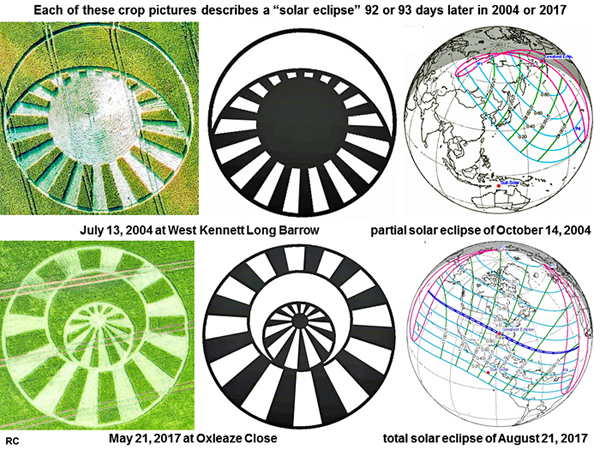
Then when we
go forward in time to find out which solar eclipse might be predicted by
the 2017 crop picture, we find a 100% total eclipse on August 21, just
92 days later, as shown in a lower part of the slide above.
In summary,
both crop pictures from 2004 or 2017 (i) look similar in appearance,
(ii) seem to describe the same kind of astronomical event (a “solar
eclipse”), and (iii) were drawn at almost the same interval of time
before a near-future solar eclipse took place (93 or 92 days
respectively).
Their 2004
crop picture suggests a Mayan calendar with 18 months per year, known as
the “Tzolkin”
What kind of
“calendar” might have been drawn within each of those two crop pictures,
by which we could specify the date of a solar eclipse? Their 2004 crop
picture suggests a Mayan-Aztec calendar with 18 months per year, known
as the “Tzolkin”:
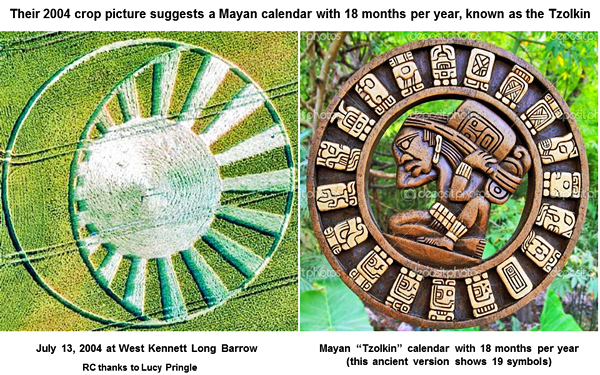
Very few (if
any) calendars on Earth today include 18 units of time for either
“months” or days”. The Metonic cycle of our Moon takes 18.6 years as
another possibility.
Their 2017
crop picture suggests a lunar calendar with 12 months per year, based
either on new and full “phases”, or North and South “nodes”
By contrast,
their 2017 crop picture suggests some kind of lunar calendar with 12
months per year. Two different kinds of lunar calendar are possible
here: one in which the visible lunar phases switch from
new-to-full-to-new, once every 29.5 days; or another in which our Moon
passes through unseen lunar nodes as North-to-South-to-North, once every
27.2 days. Each of these two possibilities would be consistent with
images shown in the slide below:
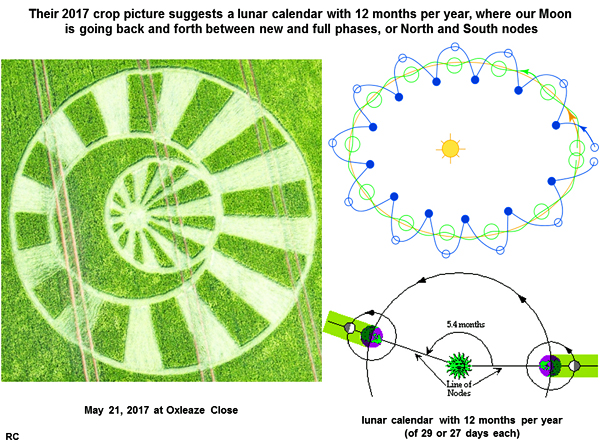
One set of
“12 bars” was drawn within and around the large outer ring of this new
crop picture, while another set of 12 bars was drawn within and around
its small inner ring. Each set of 12 bars may represent the 12 times
that our Moon goes from new-to-full-to-new, or else passes
North-to-South-to-North through its nodes, during any lunar “phase year”
or “eclipse year” respectively. Those two sets of bars were drawn offset
in angle from one another, perhaps to suggest that our Moon passes
alternatively through a North node, then a South node, then another
North node, and so on
The term
“draconic month” came from an ancient belief that some “dragon”, who
lives in the night sky, would “eat” or “swallow” our Sun or Moon during
a solar or lunar eclipse
Our Moon
passes through the same North or South node, in its orbit around the
Earth, once every 27.212 days. This is referred to as a “draconic”
month, because ancient people imagined that a "serpent" or “dragon”
lived in those night-sky nodes. Such a mythical “dragon” would
supposedly “eat” or "swallow” our Sun or Moon during any eclipse, so as
to block their light!
Just above
this new “eclipse” crop picture in the landscape, we can see the
schematic image of a “serpent” or “dragon” which has its “mouth open”,
and seems ready to metaphorically “eat” an “eclipsed Sun” which was
drawn in crops below (as indicated by a white dashed line):

Several
“bar” shapes in the landscape, located just below that “serpent” or
“dragon”, may have inspired the crop artist to draw “bar” shapes in his
new crop picture, as two sets of 12.
We can also
see a large “rabbit” shape in landscape nearby, looking at his
“astronomical clock”
When we
study landscape features which lie further away from this new crop
picture, using Google Earth (at latitude 51.417o N, longitude
1.673o W), we can also see a large “rabbit” shape in the
landscape, not far away on the right:
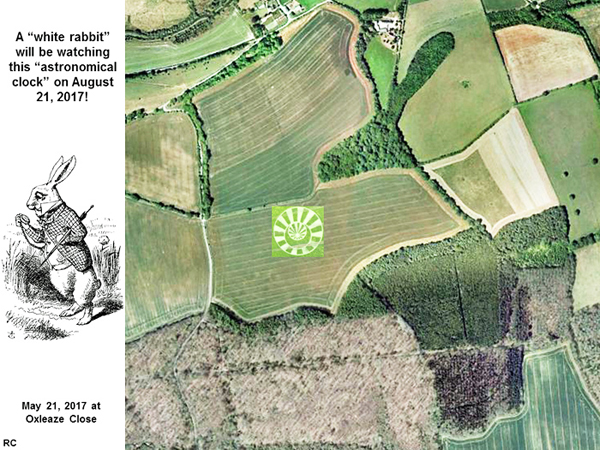
This
“rabbit” seems to be “looking carefully” at the new crop picture which
was drawn to his lower left, just as a “White Rabbit” from “Alice in
Wonderful” might look at his pocket watch:
"Oh dear! Oh
dear! I shall be too late!"
Might this
clever choice of landscape be an intentional joke by the crop artists?
And will a “white rabbit” carefully watch his “astronomical clock” on
August 21, 2017 when the next total solar eclipse takes place?
We also saw
a distinctive "rabbit" shape in the landscape near a crop picture at
Chilcomb Ranges on August 3, 2016 (see
chilcomb ranges articles).
Most crop
pictures in April or May of 2017 have shown images of “lunar crescents”
or “clocks”
The
“eclipse” image which was drawn in crops at Oxleaze Copse on May 21 was
not unexpected for this 2017 crop-circle season. Indeed, most crop
pictures in April or May of 2017 have shown the schematic images of
“lunar crescents” or “clocks”:
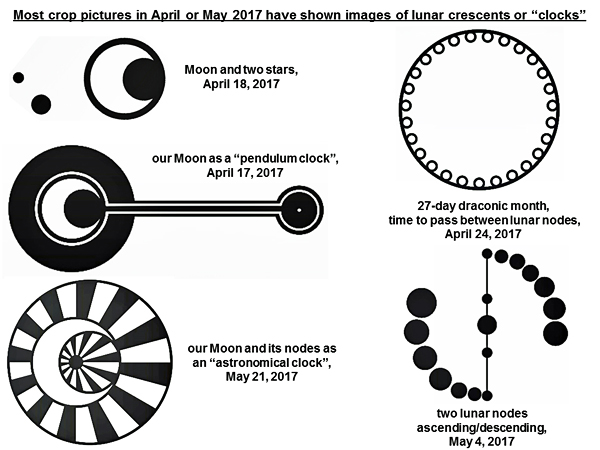
We can only
wait with keen anticipation, to see what those mysterious and crop
artists show us next!
Red Collie
(Dr. Horace R. Drew) |